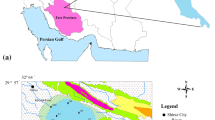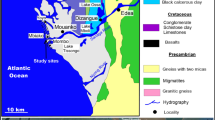Abstract
Geochemical, mineralogical and textural analyses were carried out in core sediments off Adyar estuary, Bay of Bengal, India to record the contamination trend from urban and industrial activities during the historical past. Quartz, feldspar, kaolinite, chlorite and illite were the main lithogenic and clay minerals; carbonate was the predominant biogenic mineral. Trace metals (Fe, Al, Cu, Cr, Ni, Pb and Zn) indicate more enrichment in the surface sediment layers due to recent anthropogenic activities. The mean anthropogenic factor (AF) values for trace metals in core sediments decreased in the following order: Cr > Ni > Zn > Cu > Pb. The pollution load index (PLI) values in Adyar core sediments ranged from 1 to 1.25 with an average of 1.07. Based on AF, PLI, and sediment quality guidelines values for trace metals, significant metal enrichment and ecological risk were obtained in upper-most sediment layer. Multivariate statistical methods such as correlation matrix, principal component analysis and cluster analysis were carried out to find the relationships among the texture size, metals and minerals. The pollution of Adyar estuarine sediments was started in the 1960s, responding to the rapid economic development in Chennai coastal and Adyar estuarine region in the last five decades. Despite these high concentrations in the upper layer, development and expansion of industries are still continuing. The stricter regulations for the discharge and remediation of sediments are urgent for the conservation of environments and human health.






Similar content being viewed by others
References
Achyuthan H (1997) Age and formation of oyster beds of Mutthukadu tidal flat zone, Chennai, Tamilnadu. Curr Sci 73:450–453
Ayyamperumal T, Jonathan MP, Srinivasalu S, Armstrong-Altrin JS, Ram-Mohan V (2006) Assessment of acid leachable trace metals in sediment cores from River Uppanar, Cuddalore, Southeast coast of India. Environ Pollut 143:34–45
Badr NBE, El-Fiky AA, Mostafa AR, Al-Mur BA (2009) Metal pollution records in core sediments of some Red Sea coastal areas, Kingdom of Saudi Arabia. Environ Monit Assess 155:509–526
Bertaux J, Frohlich F, Ildefonse Ph (1998) Multicomponent analysis of FTIR spectra: quantification of amorphous and crystallized mineral phases in soils and sediments. J Sediment Res 69:440–447
Biscaye PE (1965) Mineralogy and sedimentation of recent deep-sea clays in the Atlantic Ocean and adjacent seas and oceans. Geol Soc Am Bull 76:803–832
Brindley GW, Brown G (1980) Crystal structures of clay minerals and their X-ray identification. Mineral Soc Lond Monogr 5:495
Caeiro S, Costa MH, Ramos TB, Fernandes F, Silveira N, Coimbra A, Medeiros G, Painho M (2005) Assessing heavy metal contamination in Sado Estuary sediment: an index analysis approach. Ecol Indic 5:151–169
Chen Z, Salem A, Xu Z, Zhang W (2010) Ecological implications of heavy metal concentrations in the sediments of Burullus lagoon of Nile Delta, Egypt. Estuar Coast Shelf Sci 86:491–498
Fernandez Caliani JC, Ruiz Munoz F, Galan E (1997) Clay mineral and heavy metal distributions in the lower estuary of Huelva and adjacent Atlantic shelf, SW Spain. Sci Tot Environ 198:181–200
Gowri V, Ramachandran S, Ramesh R, Pramiladevi IRR, Krishnaveni K (2008) Application of GIS in the study of mass transport of pollutants by Adyar and Cooum Rivers in Chennai, Tamilnadu. Environ Monit Assess 138:41–47
Harikumar PS, Nasir UP (2010) Ecotoxicological impact assessment of heavy metals in core sediments of a tropical estuary. Ecotoxicol Environ Safe 73:1742–1747
Ingram RL (1970) Procedures in sedimentary petrology. Wiley, New York, pp 49–67
Janaki-Raman D, Jonathan MP, Srinivasalu S, Armstrong-Altrin JS, Mohan SP, Ram-Mohan V (2007) Trace metal enrichments in core sediments in Muthupet mangroves, SE coast of India: application of acid leachable technique. Environ Pollut 145:245–257
Jayaprakash M, Srinivasalu S, Jonathan MP, Ram-Mohan V (2005) A baseline study of physico-chemical parameters and trace metals in waters of Ennore Creek, Chennai, India. Mar Pollut Bull 50:583–608
Jonathan MP, Ram-Mohan V (2003) Heavy metals in sediments of the innershelf off Gulf of Manner, southeast coast of India. Mar Pollut Bull 46:263–268
Kankara RS, Mohan R, Venkatachalapathy R (2013) Hydrodynamic modeling of Chennai coast from a coastal zone management perspective. J Coast Res 29:347–357
Long ER, Field LJ, MacDonald DD (1998) Predicting toxicity in marine sediments with numerical sediment quality guidelines. Environ Toxicol Chem 17:714–727
MacDonald DD, Carr RS, Calder FD, Long ER, Ingersoll CG (1996) Development and evaluation of sediment quality guidelines for Florida coastal waters. Ecotoxicology 5:253–278
Muthuraj S, Jayaprakash M (2008) Distribution and enrichment of trace metals in marine sediments of Bay of Bengal, off Ennore, southeast coast of India. Environ Geol 56:207–217
Nobi EP, Dilipan E, Thangaradjou T, Sivakumar K, Kannan L (2010) Geochemical and geo-statistical assessment of heavy metal concentration in the sediments of different coastal ecosystems of Andaman Islands, India. Estuar Coast Shelf Sci 87:253–264
Purvaja R, Ramesh R (2001) Natural and anthropogenic methane emission from coastal wetlands of South India. Environ Manag 27:547–557
Rajkumar AN, Barnes J, Ramesh R, Purvaja R, Upstill-Goddard RC (2008) Methane and nitrous oxide fluxes in the polluted Adyar River and estuary, SE India. Mar Pollut Bull 56:2043–2051
Raju K, Vijayaraghavan K, Seshachalam S, Muthumanickam J (2011) Impact of anthropogenic on physicochemical parameters and trace metals in marine surface sediments of Bay of Bengal off Chennai, India. Environ Monit Assess 177:95–114
Ramesh R, Purvaja R, Parashar DC, Gupta PK, Mitra AP (1997) Anthropogenic forcing on methane efflux from polluted wetlands (Adyar River of Madras city, India). Ambio 26:369–374
Ramesh R, Purvaja R, Ramesh S, James RA (2002) Historical pollution trends in coastal environments of India. Environ Monit Assess 79:151–176
Ray AK, Tripathy SC, Patra S, Sarma VV (2006) Assessment of Godavari estuarine mangrove ecosystem through trace metal studies. Environ Int 32:219–223
Romic M, Romic D (2003) Heavy metals distribution in agricultural topsoils in urban area. Environ Geol 43:795–805
Ruiz F (2001) Trace metals in estuarine sediments from the Southwestern Spanish coast. Mar Pollut Bull 426:481–489
Ruiz-Fernandez AC, Paez-Osuna F, Hillaire-Marcel C, Soto-Jimenez M, Ghaleb B (2001) Principal component analysis applied to assessment of metal pollution from urban wastes in the Culiacan river estuary. Bull Environ Contam Toxicol 67:741–748
Ruiz-Fernandez AC, Sanchez-Cabeza J-A, Alonso-Hernandez C, Martinez-Herrera V, Perez-Bernal LH, Preda M, Hillaire-Marcel C, Gastaud J, Quejido-Cabezas AJ (2012) Effects of land use change and sediment mobilization on coastal contamination (Coatzacoalcos River, Mexico). Cont Shelf Res 37:57–65
Saikia BJ, Parthasarathy G, Sarmah NC (2008) Fourier transform infrared spectroscopic estimation of crystallinity in SiO2 based rocks. Bull Mat Sci 31:775–779
Singh M, Muller G, Singh IB (2003) Geogenic distribution and baseline concentration of heavy metals in sediments of the Ganges River, India. J Geochem Explor 801:1–17
Soylak M, Turkoglu O (1999) Trace metal accumulation caused by traffic in agricultural soil near a motorway in Kayseri-Turkey. J Trace Microprobe Tech 17:209–217
Soylak M, Divrikli U, Saracoglu S, Elci L (2002) Monitoring trace metal levels in Yozgat-Turkey: copper, iron, nickel, cobalt, lead, cadmium, manganese and chromium levels stream sediments. Pol J Environ Stud 11:47–51
Tanner PA, Leong LS (2000) Metals in marine sediment core from near Ma Wan, Hong Kong. Water Air Soil Pollut 121:309–325
Tomlinson DC, Wilson JG, Harris CR, Jeffery DW (1980) Problems in the assessment of heavy metals levels in estuaries and the formation of a pollution index. Helgol Wiss Meeresunters 33:566–575
Turkoglu O, Saracoglu S, Soylak M, Elci L (2004) Monitoring copper, nickel, cobalt, lead, cadmium, manganese and chromium levels in house dust samples from Kayseri-Turkey. Trace Elem Electrolytes 21:4–9
Veerasingam S, Venkatachalapathy R, Ramkumar T (2012) Heavy metals and ecological risk assessment in marine sediments off Chennai, India. Carpathian J Earth Environ Sci 7:111–124
Veerasingam S, Venkatachalapathy R, Ramkumar T (2013) Distribution of clay minerals in marine sediments off Chennai, Bay of Bengal, India: indicators of sediment sources and transport processes. Int J Sediment Res (in press)
Venkatachalapathy R, Veerasingam S, Basavaiah N, Ramkumar T (2010a) Comparison between petroleum hydrocarbon concentrations and magnetic properties in Chennai coastal sediments, Bay of Bengal, India. Mar Petrol Geol 27:1927–1935
Venkatachalapathy R, Veerasingam S, Ramkumar T (2010b) Petroleum hydrocarbon concentrations in marine sediments along Chennai coast, Bay of Bengal, India. Bull Environ Contam Toxicol 85:397–401
Venkatachalapathy R, Veerasingam S, Basavaiah N, Ramkumar T, Deenadayalan K (2011a) Environmental magnetic and geochemical characteristics of Chennai coastal sediments, Bay of Bengal, India. J Earth Syst Sci 120:885–895
Venkatachalapathy R, Veerasingam S, Basavaiah N, Ramkumar T, Deenadayalan K (2011b) Environmental magnetic and petroleum hydrocarbons records in sediment cores from the north east coast of Tamil Nadu, Bay of Bengal, India. Mar Pollut Bull 62:681–690
Venugopal T, Giridharan L, Jayaprakash M, Periakali P (2009) Environmental impact assessment and seasonal variation study of the groundwater in the vicinity of River Adyar, Chennai, India. Environ Monit Assess 149:81–97
Wang X-S, Qin Y (2006) Use of multivariate statistical analysis to determine the relationship between the magnetic properties of urban topsoil and its metal, S, and Br content. Environ Geol 51:509–516
Wenning RJ, Ingersoll CG (2002) Executive summary of the SETAC Pellston workshop on use of sediment quality guidelines and related tools for the assessment of contaminated sediments. Society of Environmental Toxicology and Chemistry (SETAC), Pensacola, FL, USA
Zourarah B, Maanan M, Carruesco C, Aajjane A, Mehdi K, Conceicao Freitas M (2007) Fifty year sedimentary record of heavy metal pollution in the lagoon of Oualidia (Moroccan Atlantic coast). Estuar Coast Shelf Sci 72:359–369
Acknowledgments
This study has been carried out in the frame work of the MoES Research Project (Project No.: MoES/11-MRDF/1/13/P/07), New Delhi. The authors wish to thank the Director, Faculty of Marine Sciences, Annamalai University for providing all necessary facilities. We thank the crew of R\V Sagar Paschimi for their help during sample collection.
Author information
Authors and Affiliations
Corresponding author
Rights and permissions
About this article
Cite this article
Veerasingam, S., Venkatachalapathy, R. & Ramkumar, T. Historical environmental pollution trend and ecological risk assessment of trace metals in marine sediments off Adyar estuary, Bay of Bengal, India. Environ Earth Sci 71, 3963–3975 (2014). https://doi.org/10.1007/s12665-013-2781-5
Received:
Accepted:
Published:
Issue Date:
DOI: https://doi.org/10.1007/s12665-013-2781-5




